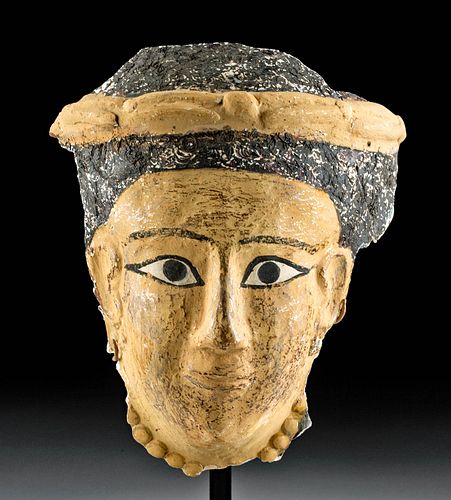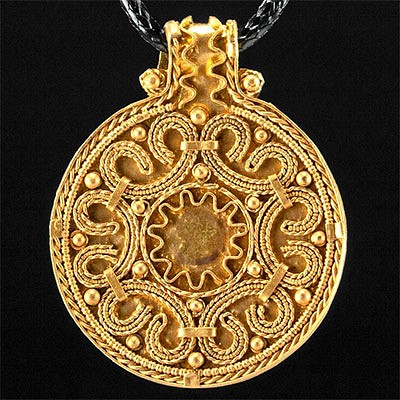Romano-Egyptian Polychrome Cartonnage Mummy Mask
Lot 20
About Seller
Artemis Gallery
686 S Taylor Ave, Ste 106
Louisville, CO 80027
United States
Selling antiquities, ancient and ethnographic art online since 1993, Artemis Gallery specializes in Classical Antiquities (Egyptian, Greek, Roman, Near Eastern), Asian, Pre-Columbian, African / Tribal / Oceanographic art. Our extensive inventory includes pottery, stone, metal, wood, glass and textil...Read more
Estimate:
$4,000 - $6,000
Absentee vs Live bid
Two ways to bid:
- Leave a max absentee bid and the platform will bid on your behalf up to your maximum bid during the live auction.
- Bid live during the auction and your bids will be submitted real-time to the auctioneer.
Bid Increments
| Price | Bid Increment |
|---|---|
| $0 | $25 |
| $300 | $50 |
| $1,000 | $100 |
| $2,000 | $250 |
| $5,000 | $500 |
| $10,000 | $1,000 |
| $20,000 | $2,500 |
| $50,000 | $5,000 |
| $100,000 | $10,000 |
| $200,000 | $20,000 |
About Auction
By Artemis Gallery
Aug 19, 2021
Set Reminder
2021-08-19 10:00:00
2021-08-19 10:00:00
America/New_York
Bidsquare
Bidsquare : Ancient & Ethnographic Art Through The Ages
https://www.bidsquare.com/auctions/artemis-gallery/ancient-ethnographic-art-through-the-ages-7345
Ancient art from Egypt, Greece, Italy and the Near East, as well as Asian, Fossils, Pre-Columbian, Native American, African / Tribal / Oceanic, Fine art, and much more! All categories, all price ranges... all legally acquired and guaranteed to be as described or your money back. Artemis Gallery info@artemisgallery.com
Ancient art from Egypt, Greece, Italy and the Near East, as well as Asian, Fossils, Pre-Columbian, Native American, African / Tribal / Oceanic, Fine art, and much more! All categories, all price ranges... all legally acquired and guaranteed to be as described or your money back. Artemis Gallery info@artemisgallery.com
- Lot Description
Egypt, Romano-Egyptian period, ca. 30 BCE to 300 CE. A striking cartonnage sarcophagus mask of a woman's face, made from layers of plaster-covered papyrus and painted with bright pigments. The visage is painted in hues of yellow ochre, black, and white atop a layer of gesso. The dramatic eyes are outlined with stark black pupils to mimic kohl cosmetic eyeliner. She bears an aquiline nose above thin lips in an enigmatic smile. Her coiffure is arranged atop her head and painted in black, swirling lines representing strands of hair under an ochre wreath of laurel leaves. The ground color of the face is a yellow ochre with traces gilding on the surface. Her ears and neck are adorned with beaded jewelry. A shift towards more naturalistic features, as seen here, reflects the profound change that the Greco-Roman world brought to Egypt. Depictions of a deceased person's distinctive face, full head, or body replaced the stylized art of dynastic Egypt. This lovely lady is a outstanding example of funerary art. Size: 7.215" L x 5.75" W (18.3 cm x 14.6 cm); 10" H (25.4 cm) on included custom stand.
A mask like this would have been placed over the face and fastened into the linen wrappings of a mummy. Death masks were created for the soul to recognize the body and return to it, and so masks were made in the relative likeness of the deceased. Such portrait masks are significant, because they demonstrate conclusively that Greco-Roman individuals represented in encaustic paintings also subscribed to traditional Egyptian beliefs about the afterlife.
Interestingly, Roman Egypt was a multicultural society, and this provided great resources for portraiture. The sculptural style and painting technique of this example, for instance, speaks to Greco-Roman traditions of realism with sensitive modeling that allows for shadows and highlights on the face. What's more, since virtually no paintings from the ancient Greeks have survived, mummy portraits - both paintings and painted masks like this example - are the only examples that can point to one of the purportedly highest achievements of Greek culture. Furthermore, the clothing, jewelry, and hairstyles depicted present fashions that embraced eastern Mediterranean preferences.
This piece has been searched against the Art Loss Register database and has been cleared. The Art Loss Register maintains the world’s largest database of stolen art, collectibles, and antiques.
Provenance: private New York, New York, USA collection, 2000s; ex-private Scottsdale, Arizona, USA collection
All items legal to buy/sell under U.S. Statute covering cultural patrimony Code 2600, CHAPTER 14, and are guaranteed to be as described or your money back.
A Certificate of Authenticity will accompany all winning bids.
PLEASE NOTE: Due to recent increases of shipments being seized by Australian & German customs (even for items with pre-UNESCO provenance), we will no longer ship most antiquities and ancient Chinese art to Australia & Germany. For categories of items that are acceptable to ship to Australia or Germany, please contact us directly or work with your local customs brokerage firm.
Display stands not described as included/custom in the item description are for photography purposes only and will not be included with the item upon shipping.
#164565Fragment of a larger section. Repaired with large piece reattached on upper right corner and visible break line. Chipping and fading of paint. Light mineral and earthen encrustations to verso. Good preservation of facial features.Condition
- Shipping Info
-
All shipping is handled in-house for your convenience. Your invoice from Artemis Gallery will include shipping calculation instructions. If in doubt, please inquire BEFORE bidding for estimated shipping costs for individual items.
-
- Buyer's Premium



 EUR
EUR CAD
CAD AUD
AUD GBP
GBP MXN
MXN HKD
HKD CNY
CNY MYR
MYR SEK
SEK SGD
SGD CHF
CHF THB
THB














